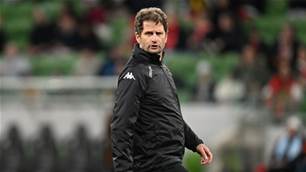Victory might have gone six goals up against the Jets a couple of rounds back, but no one was celebrating
Melbourne Victory might have gone six goals up against the Newcastle Jets a couple of rounds back, but no one was celebrating the win. In fact, the atmosphere was shocked and sombre, with players on both teams and fans issuing variations of the same sentiment: ‘I hope it’s not as bad as it looks.’
The days preceding the match had held a frisson of excitement: 19-year-old Ashley Brown was set to return from just over 12 months out with an ACL injury. (Coincidentally, her brother, Jordan Brown, returned for the Victory Youth League team from 18 months out battling osteitis pubis in the same week)
Brown is an incredible talent who’d come to our attention through her solid W-League and Matildas performances at the age of 17 and is widely considered to be one of the next generation’s top Matildas. The well wishes for her return had been pouring in from far and wide.
Brown started well, with little hint she’d had some 12 months out. Just minutes before the final whistle, though, she landed awkwardly, her knee buckled, and it was immediately clear she was in significant distress.
Social media lit up with concern as Brown was stretchered off the pitch and everyone waited for confirmation of what we knew was inevitable but hoped wasn’t. Former Matilda, now mentor and ABC W-League commentator Sarah Walsh summed it up when she said ‘my heart went out to her’.
Walsh has herself gone through three knee reconstructions and more arthroscopies than she can count—no, really, she’s trying to track down her medical records so she can determine the exact number—so she understands well the wrenching devastation at reinjuring a reconstructed knee.
A day later, Brown tweeted: ‘Thanks for everyone's amazing messages of support. Really appreciate it; however, unfortunately it is the ACL again :( #roundtwo’
Weeks before, another top Matilda, Kyah Simon, tore her ACL in what I’ve since discovered was the classic fashion: she pushed off and her knee dipped inward, with the ACL rupturing and Simon’s leg crumpling beneath her.
And so we find ourselves returning to the familiar conversation: What is it about knees? And what is it about women’s knees in particular?
It’s not often I call attention to the differences between men and women playing football—I spend so much time trying to show we women can hold our own. But with women anywhere between two and eight times more likely to tear their ACLs than men (depending on which research you look at) and 25% more likely to sustain a second knee injury when they return, it’s time, I figured, to get around to updating the knee-themed blog I wrote some almost-four years back. Sadly, after two knee reconstructions, Jenna Tristram (the Matilda and W-League player it features) no longer plays football.
Women’s football has had a tough few years injury-wise, with around six players from the victorious Asian Cup side undergoing knee reconstructions and rehabilitation since 2010. But while the inclination might be to bandy around terms such as ‘epidemic’, it’s important first to find out what’s causing these injuries and if they’re out of the ordinary (whatever could be considered ‘ordinary’ when you’re talking about a devastating injury no one ever wants to have).
The short version is that there are a number of interwoven factors at play, and that while ACL injuries are the bane of women’s football, they’re also the bane of sports all round (particularly those characterised by sudden changes of direction, pivoting, accelerations and decelerations). They’re even far from exclusive to Australian women’s football (even though it feels as though we’ve been hit hard by them in recent times).
At a population level, males generally have a higher annual incidence than females, almost certainly due to an exposure bias in that males are more likely to play higher-risk sports. Professional and elite squads also generally have a higher rate of injuries/surgeries than amateur squads. There are a number of possible explanations for this. For starters, they are more likely to have the ACL injury diagnosed, as they require knee stability to continue to perform. It is also likely that these players play more games annually and train for longer periods with increased intensity, also increasing the exposure to injury.
The year Lydia Williams did her ACL, she was one of some 18 players to do so in the Swedish league. Interestingly, Scandinavian countries have funded a national ACL register that records every ACL injury at both pro and amateur level. It’s an important step, as further research is required to determine differences between incidence rates in different countries. We don’t yet have such a register in Australia.
Australian Rules Football (AFL) experiences approximately one ACL injury per club per season. Geelong player Daniel Menzel has the dubious honour of being the first AFL player to undergo four ACL reconstructions. Like Brown, he re-tore his ACL his first game back.
Former Matildas strength and conditioning coach Ian McKeown now works in AFL. He pointed me towards me Robbie Gray’s howls-of-wince-inducing injury from two seasons back I hadn’t seen it until now and, frankly, now can’t un-see it. Suffice to say, that video alone is proof other sports are far from immune.
(As a side note, AFL keeps stats and releases an annual injury report, signifying its clear commitment to injury prevention, or at least reduction).
Matildas physiotherapist Kate Beerworth tells me that the reasons for the gender gap are not completely clear. Various researchers have suggested differences in anatomy, hormonal, and neuromuscular function as the potential reasons for the higher risk in women than in men. To date, there is little evidence linking all these potential intrinsic risk factors to non-contact ACL injuries and a great deal of controversy exists on the relative importance of the different risk factors.
Broken down, those factors are as follows.
Anatomical structure
Basically, women are built differently from men. The distribution of load our bodies’ structures place on our ACLs and the angles involved seem to be—generally speaking—greater than men’s. This is a non-modifiable risk factor.
Hormones
There is significant conjecture as to whether hormones contribute to the increase number of ACL injuries in females. Either way, this is a non-modifiable risk factor.
Neuromuscular control
Neuromuscular control relates to such things as how we jump and how we land. Women do this differently from men, generally using their quads to keep their knees straight, while men use their hips and glutes. Except women don’t often keep their knees straight—our knees tend to drop inwards (known as ‘valgus’), applying extra pressure to the ACL.
Another contributing factor is that ACL injuries are most likely to occur in women 18–20 years of age. Many of the Matildas fall within that age bracket—you’ll recall the Matildas had the youngest average age of all the teams in the 2011 Women’s World Cup, and we played our youngest player, the then 16-year-old Caitlin Foord, against Marta, the seasoned striker who’s five times won the Ballon d’Or.
Load is also a factor. Limited funding means players train and play part time, and yet they’re increasingly being exposed to ever-faster play and ever-greater workloads. ‘I remember from my first time with the Matildas the number of ACLs we had was huge,’ former Matildas and now US Women’s National Team coach Tom Sermanni says, ‘and I think it was because we the players went from very little training and competition to a significant load.’
Throw in other conditions such as varied pitch surfaces and, well, you’re playing a Sisyphean game of ACL-cause-and-prevention Whac-A-Mole.
The bad news, Beerworth tells me, is that we can’t change our anatomical or hormonal make-ups—we’re built the way we’re built and our hormones act however they damn well please. The good news is that we can improve our neuromuscular control and work on strength and conditioning.
A variety of injury specific and sport specific preventative exercise programs exist. Studies show that establishing standard warm-up programs can reduce the risk of injury by 30–50%. Enter knee injury prevention programs such as FIFA 11+ [link to: http://f-marc.com/11plus/home/], a series of exercises designed to strengthen muscles around knees, improve control for such movements as landing, and get players warmed up for training and playing. The Matildas incorporate such a warm-up consisting of exercises focusing on dynamic stability, balance, core stability, and muscle strength at every training session.
Some 70% of ACL injuries are non-contact and come from an awkward landing or knee giving way (and caving in) when pushing off to change direction. That is, the same way Simon injured her knee. Good technique with an emphasis of ‘hip-knee-toe in line position’ obtained through practising 11+ regularly and accurately may go some way to reducing these particular ACL injuries.
And practising it early is crucial, Beerworth tells me. Research indicates that the best results for ACL injury prevention for both men and women come from starting in pre-adolescence.
Likewise, Beerworth says, identifying players who are at greater risk because of biomechanics or poor technique and helping them before they are injured will help. ‘Awareness is key—ACL prevention programs do work,’ Beerworth says. ‘As is good execution.’ That is, 11+ is great, but you need to make sure you’re practising it as it’s designed to be with good technique.
The Matildas’ approach to knee reconstruction rehabilitation is comparatively conservative, with players required to rehab for a full 12 months before they’re allowed to resume playing. That’s in contrast to countries such as the US where players are sometimes allowed back after as little as seven months. However, studies suggest a high rate of a secondary knee injury if functional goals are not met in the rehab process.
With all players who’ve undergone ACL reconstructions prone to early osteo-arthritis, which potentially shortens their careers, Beerworth points out that managing players’ health long term is integral. ‘A successful outcome is not how quickly they get back,’ Beerworth says, ‘but if they’re still playing in five years’ time.’
Which means we won’t be seeing either Brown or Simon back on the pitch for a full year (nor Newcastle’s Maddie Searl, who tore her ACL just days ago), and neither will be in the Matildas squad that defends the Asian Cup crown (that’s a double blow when you remember that Simon was the player who scored the fifth and final penalty to give Australia the win over DPR Korea). But we will hopefully be seeing them back both in the W-League and the Matildas longer term, including for the 2015 Women’s World Cup.
In the interim, we can spread the knowledge that ACL prevention works and establishing consistent warm-up routines is important. So a note for all coaches and budding footballers (any age, male or female): You should be all be downloading and practising the 11+ program and pushing for a national register of ACL injuries so we can better track their incidence. Because whether at a pro or amateur level, knee injury prevention is better than rehab.
Related Articles

'Timing not right': Montemurro's verdict on Matildas vacancy

Matildas: 'Fourth at the Olympics is honestly the worst place you could come'
.jpg&h=172&w=306&c=1&s=1)












